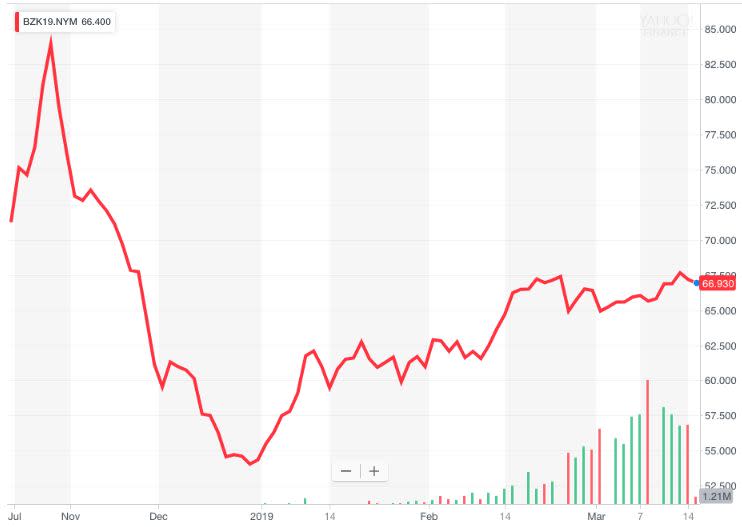Why Brent crude oil prices could go north of $70 despite a cooling economy
Rising crude prices, which touched a 2019 high on Friday, may not be done just yet.
With global oil markets still grappling with the loss of supply from crisis-hit Venezuela and cuts in production from major international crude producers, Goldman Sachs on Friday said Brent crude (BZ=F) could rally above $70 in the near-term, bolstered by resilient global demand and the loss of production from Libya, another epicenter of civil strife.
Libya’s oil production averaged just under a million barrels per day in 2018, down sharply from pre-war levels of around 1.6 million.
“Supply loses are exceeding our expectations, demand growth is beating low consensus expectations with technicals supportive and net long positioning still depressed,” Goldman’s analysts wrote.
“On the supply side, the production losses to start 2019 remain large with core-OPEC producers adopting a ‘shock and awe’ strategy and exceeding their cut commitment,” the bank added.

If Goldman’s assessment is accurate, rising oil prices could spur a jump in gasoline prices, which the AAA said recently are already edging higher ahead of the spring driving season. Meanwhile, sources told Reuters that OPEC producers and their partners are expected to extend their cuts to oil supply when they meet in June, a decision likely to keep prices elevated.
Energy markets are being buffeted by a number of economic crosswinds. The potential surge in energy prices adds another layer of uncertainty to a global economy that’s shown clear signs of moderating, with recession fears beginning to percolate.
Last month, the International Energy Agency forecast that demand this year would slow to a crawl. “Slowing economic growth will...limit any upside,” the agency wrote in its annual report.
However, some market participants are calculating a fleeting boost in global demand that may result from a potential resolution of the U.S.-China trade war.
“Looking ahead, more concrete signs of a trade deal between the US and China would give a temporary lift to commodity prices,” Capital Economics wrote in a research note to clients.
The firm sees prices rising as high as $65 by the end of the first quarter, before falling as low as $50 by year’s end.
Javier David is an editor for Yahoo Finance. Read more:
Investors are too confident that the US-Mexico-Canada trade accord is a done deal
Wall St mulls sub-2% U.S. growth as consumers cut back on spending
Here's why almost nobody likes the ECB's 'roach motel' cheap money policy for banks
Follow Javier on Twitter: @TeflonGeek

 Yahoo Finance
Yahoo Finance 